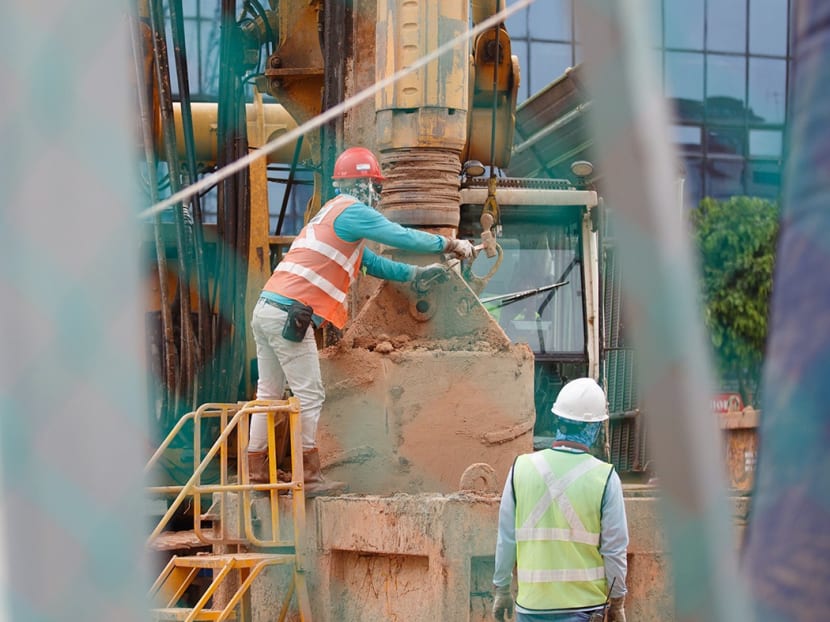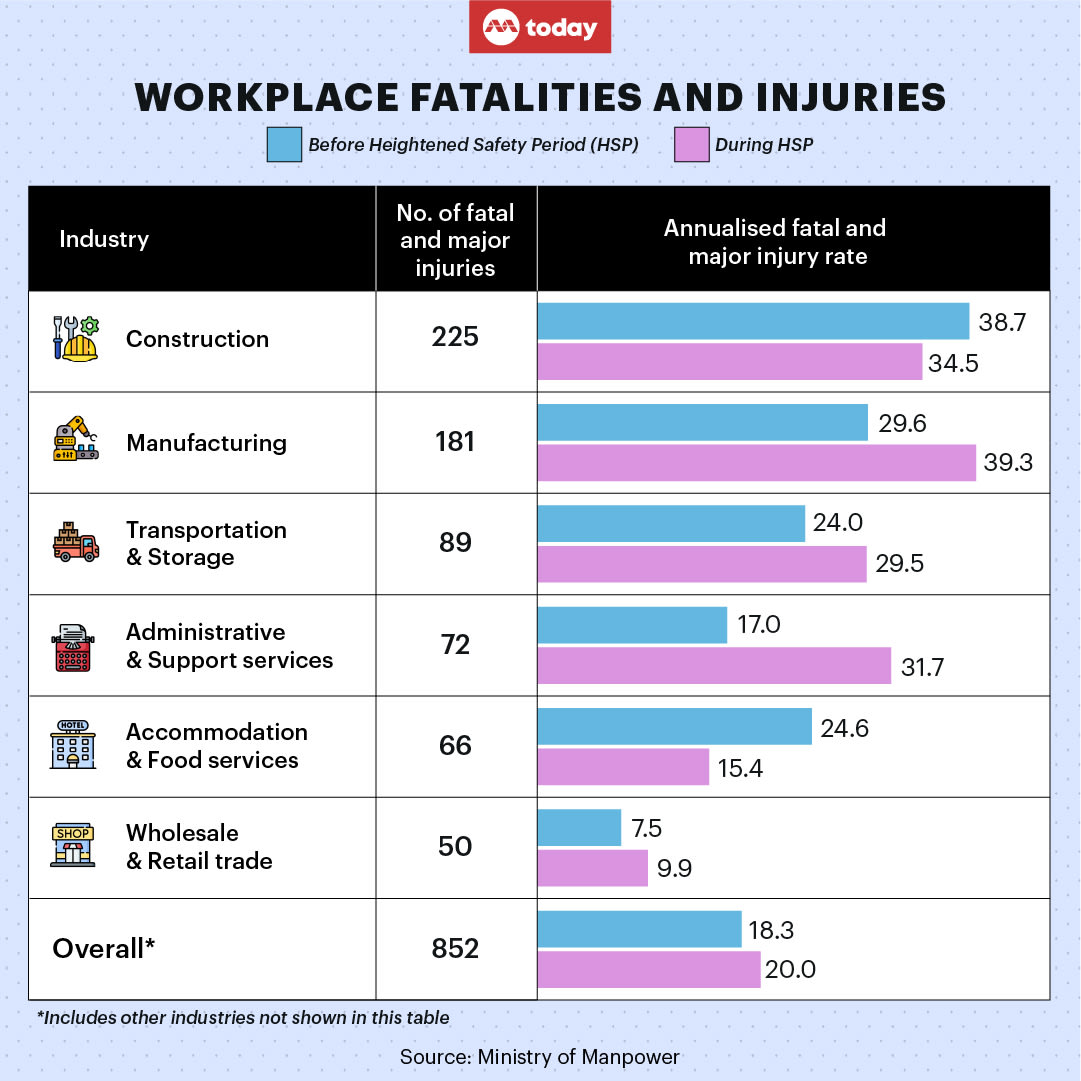New workplace measures, including demerit points for manufacturers, after major injuries rise in heightened safety period: MOM
SINGAPORE — Workplace deaths are down under a heightened safety period that ends on May 31, but major injuries are up, prompting an extension of a demerit point system to the badly performing manufacturing sector, among other fresh measures.

- A heightened safety period that started in September 2022 to lower workplace fatalities will end on May 31, 2023
- This is due to an improvement in the rate of workplace deaths
- However, after a jump in major injuries, the Ministry of Manpower will be introducing new workplace safety measures
- They include extending the demerit point system to the manufacturing sector
- Firms with major safety and health lapses can be barred from hiring foreign workers for up to two years, for instance
SINGAPORE — Workplace deaths are down under a heightened safety period that ends on May 31, but major injuries are up, prompting an extension of a demerit point system to the badly performing manufacturing sector, among other fresh measures.
On Tuesday (May 23), the Ministry of Manpower (MOM) announced that it would not be further extending the heightened safety period, which kicked in last September and was extended from Feb 28 to May 31.
Instead, it will introduce measures to be known as Safety Accountability, Focus and Empowerment (Safe), which aim to “encourage the industry to take ownership of workplace safety" on the basis that "it is the right thing to do”.
This is unlike the heightened safety period, which involved “heavy-handed” measures such as mandatory safety timeouts that paused company operations for a period, MOM said.
In response to queries from TODAY, the ministry said that 16 chief executives were required to take responsibility for workplace safety and health rectifications after serious or fatal accidents.
As of the end of April this year, about 1,300 composition fines amounting to more than S$2.6 million were issued during the heightened safety period. Most of these fines were given for unguarded openings or open sides, unsafe means of access and unsafe scaffoldings.
WHY THIS MATTERS
Between Jan 1 and Sept 1 last year, there were 36 workplace deaths, one fewer than the whole of 2021.
For the full year, there were 46 deaths in 2022, compared to 37 in 2021.
Mr Zaqy Mohamad, Senior Minister of State for Manpower, said previously that many of these deaths could have been prevented with basic precautions, prompting MOM to put in place the heightened safety period from Sept 1, 2022 to March 1, 2023.
They included holding chief executives of errant companies liable for unsafe workplace conditions, and barring companies from hiring foreign employees for up to three months if found to have serious workplace and health breaches.
However, after four workplace deaths between Jan 1 and Feb 10 this year, and an expected increase in injuries after Chinese New Year as workplaces rush to compensate for lost time, MOM extended the period for three months.
Since the heightened safety period, MOM has seen a decline in the workplace fatality rate.
The workplace fatality rate for every 100,000 workers dropped from 1.5 for January to August 2022 to 0.8 for September 2022 to date.
The rate was lower than its 2028 target of 1.0.
However, the major injury rate for every 100,000 workers worsened.
It went from 16.8 before the heightened safety period (January to August 2022) to 19.2 during the heightened safety period (September 2022 to March 2023).
These injury numbers also showed a need for more sector-specific intervention to improve workplace safety, MOM said.

The construction sector remained the top contributor of workplace fatal and major injuries in terms of absolute numbers, but it also showed the most improvement in these rates during the heightened safety period.
However, in the manufacturing sector, the major injury and fatality rate worsened from 29.6 per 100,000 before the heightened period to 39.3 during the heightened safety period, MOM noted.
This meant that manufacturing was the worst performing sector, exceeding construction, it added.
When comparing the change in monthly averages during the heightened safety period and before its implementation in 2022, the number of injuries with a higher fatality risk, such as falls from heights, rose by 0.7 in the manufacturing sector.
Injuries with less fatal risk, such as those involving machinery, went up by 2.8 during this period in the sector.
WHAT ARE THE NEW SAFETY MEASURES?
1. HIRING RESTRICTIONS, DEMERIT POINTS SYSTEM
Among various new measures — most of which will be implemented within the next six months to a year — is the extension of the demerit points system to the manufacturing sector.
Right now, construction companies may be banned from hiring foreign employees for up to two years should they accumulate demerit points for poor workplace safety and health performance.
As of May 8, 25 companies were not allowed to hire foreign employees for up to three months, MOM told TODAY.
From October this year, manufacturing companies will also be given demerit points should they record workplace safety and health breaches.
Errant companies with consistently poor workplace safety and health performance that accumulate 25 points or more in an 18-month period will not be able to hire foreign employees or renew existing work passes.
2. SAFETY REQUIREMENTS AS PART OF TENDER EVALUATION
Companies looking to apply for Government Procurement Entities' tenders will also have their workplace safety measures form part of the evaluation requirements.
Public construction and construction-related projects will have a minimum safety weightage of at least 5 per cent for tender evaluation. this means that at least 5 per cent of the evaluation of the tender bid relates to safety matters.
For now, projects with a value of more than S$3 million have to follow the price quality framework, where the safety weightage ranges between 3 per cent and 6 per cent. With this new measure, the safety weightage will be extended to more projects, MOM said.
More details on this will be announced in due course, it added.
Some other measures that will be introduced include:
- Construction sites for projects valued above S$5 million must have a video surveillance system from June 2024
- Workplace safety and health regulations will be enhanced to ensure the safe use of machinery and combustible dust from June 2024
- Providing more support to small- and medium-sized enterprises (SMEs) with workplace safety and health matters through SME centres from June 2023
- Requiring workers in higher-risk industries to attend online micro-learning modules as part of their safety orientation course recertification assessment from January 2024
- Enhancing the workplace health surveillance programme by requiring workplaces to declare workplace health hazards, among other things, from May 2023
WHAT ARE THE EXISTING MEASURES RETAINED?
MOM also said that some existing measures introduced during the heightened safety period will be retained. They include:
- Requiring chief executives and board members to personally account for workplace safety and health lapses after incidents
- Making companies with major injuries or fatalities, or with a stop-work order, to engage an external auditor to conduct a review of their workplace safety and health processes
- Requiring chief executives to attend a half-day in-person work-safety programme should their company be found with serious workplace safety and health lapses after serious or fatal incidents
While it will have in place safe measures, MOM said that it will not rule out the possibility of implementing another heightened safety period should “there be a need to”.












